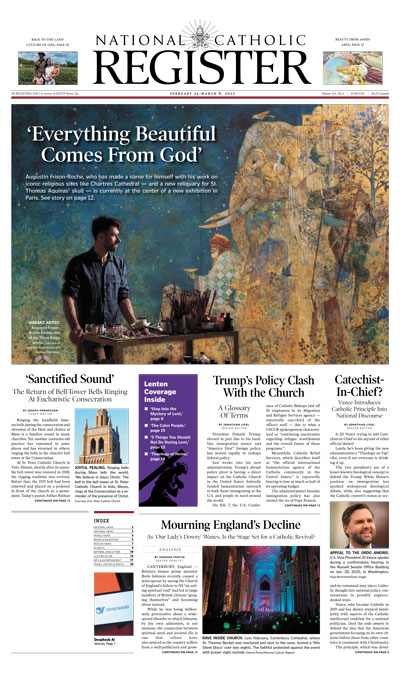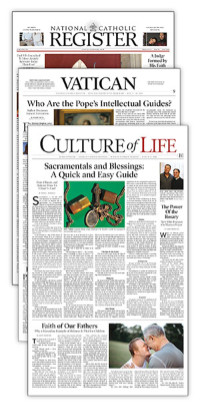Why a Rising Ultra-Marathoner Runs — to Fight for Young Catholic Men and Authentic Brotherhood
Johnny Kuplack has embarked on a 100-day run to Auriesville, New York, where his 3,500-mile jog will end at the National Shrine of the North American Martyrs, which was just designated a national shrine by the U.S. bishops.

Johnny Kuplack puts down his cappuccino and springs up to greet me. He has the stereotypically lithe, compact body of a distance runner. I learn that, after our meeting, while I grind through a 25-minute workout, Kuplack will do a quick 5-kilometer run up and down Phoenix’s Camelback Mountain. Then do it again.
For Kuplack, that’s a light morning, a way to stay loose as he prepares for the main event. In a few days, he’ll run 35 miles, or thereabouts. He’ll do the same the next day, and the next — for 100 consecutive days. Starting on Jan. 18 at Dana Point, California, he began a run to Auriesville, New York, where his 3,500-mile jog will end at the National Shrine of the North American Martyrs, which was just designated a national shrine by the U.S. bishops.
Why would anyone do this?
For the next 30 minutes, the 36-year-old Kuplack tries to explain. He is passionate, articulate and literate, peppering his speech with quotes from the Bible, Pope Benedict and Dostoevsky. He looks at his listener with intensity. His are the eyes of a man who has seen something, something few of his contemporaries have ever seen — something he desperately needs to convey.

Catholic Upbringing
Kuplack (pronounced kyoop-lik) was raised in a traditional Catholic family. At 14, he entered St. Gregory’s Academy, an all-male boarding school operated by the Priestly Fraternity of St. Peter in Elmhurst, Pennsylvania. The experience was transformational. The curriculum — modeled on the famous Integrated Humanities Program started by John Senior at the University of Kansas in the 1970s that formed Bishop James Conley of Lincoln, Nebraska — combined rigorous academics with equally rigorous physical activity, from farm work to rugby. St. Gregory’s also instilled in its students a powerful master narrative by which to understand the world and themselves. Most of Kuplack’s schoolmates became lifelong friends.
After St. Gregory’s, the real world was a letdown.
“There was no joy of the band of brothers, no Achillean challenge,” he recalls. A life of comfort and low bars held no attraction for him. Kuplack started searching, for what he didn’t exactly know. From age 19 to 21, he hitchhiked his away around much of the globe. “I was looking for someone who was living a better life. I knew it had to be out there.”
At 32, Kuplack found himself in Gallup, New Mexico. There, he reconnected with his high-school buddy Jeremy Gay. The two friends lamented what they saw as a lack of genuine masculinity in themselves and their peers. They saw how hard it was for the young men around them to accomplish even the most basic things. Many of them “were struggling to live good lives on the daily,” Kuplack says, “let alone excelling at anything.” No one seemed to know how to become a man like those Kuplack and Gay had encountered at St. Gregory’s, whether in person or in its curriculum.
Kuplack and Gay responded by “drinking the Kool-Aid of the New Stoicism,” says Kuplack. Perhaps if they could just master the right practices, they “could unlock the secret, break into the next level of being.” Structure, self-discipline, and austerity could make them real men, satisfied men, happy men.
It didn’t work. At base, Kuplack and Gay remained angry, anxious, and afraid.
A priest friend told them, “You guys are great pagans. But you don’t have God.” They had implicitly thought they could will their way to holiness, and construct a stairway to heaven, all on their own. “I discovered that relationship wasn’t captured in my schedule,” says Kuplack. “Discipline had become my god, my path to freedom, my path to happiness. And it came up so short.”
“We discovered for the first time that our identity really is that we are most beloved sons of God,” Kuplack continues. “What we were looking for could only be found in that. That’s where meaning is.” Self-discipline had to be accompanied by a release of the self to God.
Easier said than done. How could young men like them get to a place where they truly understood that, where they could let go of their addictions (pornography, alcohol, video games), give totally and fully of themselves to God, and enter into a genuine relationship with Jesus Christ?
Stoicism wasn’t the answer. But, Kuplack and Gay determined, breaking down physical barriers was the key to breaking down spiritual ones — barriers most men didn’t even know they were there.
Reconnecting With God
In 2022, as he was wrestling with these insights, Kuplack was teaching at a charter school in Gallup. Because the kids at the school tended to come from families with high levels of poverty and dysfunction, it was hard to get their attention, let alone raise their sights.
One day, he isn’t sure why, Kuplack found himself telling his students that he was going to run a 50-mile race the next weekend. “I had never run anything close to that distance,” Kuplack chuckles. Not only did he finish first; he set a course record.
Without knowing it, Kuplack possessed a special gift, a gift all that self-discipline had prepared him to open. But opening it came with a cost.
“You come face-to-face with your own weakness when you run” such distances, says Kuplack. He remembers curling up on the trail and crying. He remembers that immediately after completing his first 100-miler he felt a hole somewhere in his deepest depths, “because all the things you’ve buried have risen up.”
He remembers realizing, in an ineffably profound way, how weak he was, and then opening — or being opened — to God like he never had been before, feeling God’s love like he never had before. “So this is what God’s talking about,” thought Kuplack. “This is the strength of his love.” Suddenly, everything made sense.
Kuplack has now run 10 ultra-marathons. They don’t all end with revelations. But four times he has finished second. Six times he has finished first.
With a record like that, he must have sponsors, right? Not yet, says his friend Joe Meyers, who is serving as Kuplack’s driver, crew and all-around wingman for their 100-day journey across the country. Kuplack is not adept at self-promotion. He is not on social media, he doesn’t own a phone, and he has never even sent a text. So despite his success on the ultra-marathon circuit, “nobody knows who he is.”
That doesn’t bother Johnny, except that he knows his late-discovered talent for long-distance running could give him a platform for Sebaste, the nonprofit organization he and Gay founded in 2021 to cultivate authentic brotherhood. It’s to draw attention to Sebaste’s work for Catholic men, and to expand its capacity, that he is putting his body through this grueling 3,500 miles. He wants others to see what he has seen, experience what he has experienced — and draw closer to God themselves.

Named after 40 martyrs of A.D. 320, Roman soldiers who were tortured and killed for their devotion to Christ, Sebaste helps young men, primarily between the ages of 18 and 23, grow in “masculine virtue” through physical fitness. The program, as one might expect, is intense. There is no tech. There is little comfort. And there is nowhere to hide.
The goal, says Kuplack, is to force participants to confront and heal “the self-loathing that comes with addiction to sin.” He wants to help men stop “living out of fear. The devil wants us to stay in that place. And he wants us to stay small.”
God the Father is the opposite. He “wants to give us everything. But until you open your hands and let go of whatever you’re holding onto” — some sin, some disordered attachment, some fear —“he can’t give you the gift he wants to give you.”
Currently, Sebaste serves about 20 young men per summer. The organization gets more than 100 applicants, however, and the number is growing. Diocesan vocational directors are calling. So are schools and colleges. The market is there because the need is there. Kuplack hopes to raise $250,000 over the course of his 3,500-mile run so that Sebaste can better serve souls.
Kuplack reminds me that not only did Father Jogues die in Auriesville; St. Kateri Tekakwitha was also born there. His journey is intended to pay homage to her, too, for men don’t just need brotherhood; they also need women. It turns out that’s another lesson about relationship Kuplack has recently learned. On Dec. 12, the feast of our Lady of Guadalupe, he got married. His cross-country run was “already in the works” when he got engaged, he says.

Our interview ends at Kuplack and Meyers’ bright-red camper van. Customized but spare, the vehicle will be their home for the next three-plus months, until that day when, God willing, Kuplack ends his run on his knees inside the National Shrine of the North American Martyrs, praying for the intercession of St. Jean de Brébeuf, St. Isaac Jogues, and their companions, men who knew the life-giving joy — and ultimate cost — of acting as men fully alive.
Jeremy Beer writes from Phoenix. He is the author of Beyond the Devil’s Road: Francisco Garcés and the Spanish Encounter With the American Southwest (Oklahoma University Press). Read his related blog.














